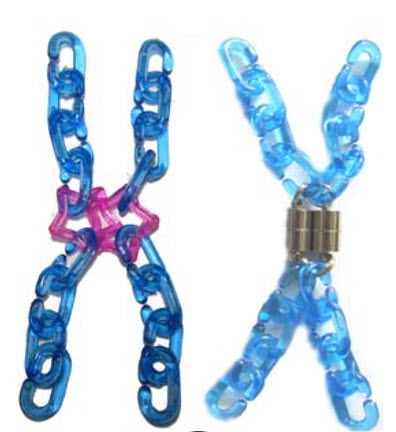โมเดลอย่างง่ายและราคาไม่แพงสำหรับใช้ในการจัดการเรียนรู้เรื่องการแบ่งเซลล์และพันธุศาสตร์ของเซลล์
Main Article Content
Abstract
Supaporn Porntrai
รับบทความ: 20 เมษายน 2557; ยอมรับตีพิมพ์: 2 มิถุนายน 2557
บทคัดย่อ
ความเข้าใจเกี่ยวกับพฤติกรรมของโครโมโซมในระหว่างการแบ่งเซลล์แบบไมโทซีสและไมโอซีส เป็นสิ่งจำเป็นสำหรับการทำความเข้าใจเกี่ยวกับการถ่ายทอดลักษณะทางพันธุกรรม แต่นักเรียนจำนวนไม่น้อยพบว่ากระบวนการนี้เป็นเรื่องยากที่จะทำความเข้าใจในสภาพการจัดการเรียนรู้ในห้องเรียน ผู้เขียนได้นำเสนอโมเดลโครโมโซมแบบใหม่ที่สามารถนำไปใช้เป็นสื่อการสอน และช่วยให้นักเรียนเข้าใจกระบวนการแบ่งเซลล์แบบไมโทซีสและไมโอซีสได้ดียิ่งขึ้น โดยเฉพาะอย่างยิ่งกระบวนการครอสซิ่งโอเวอร์ที่เกิดขึ้นระหว่างการแบ่งเซลล์แบบไมโอซีส นอกจากนั้นโมเดลนี้ยังสามารถนำไปใช้เป็นสื่อการสอนในเรื่องอื่น ๆ ที่เกี่ยวกับพันธุศาสตร์ของเซลล์ได้อีกด้วย เช่น ชนิดของโครโมโซม การแยกกันของโครมาติด โครโมโซมคู่เหมือน แคริโอไทป์ พลอยดี วัสดุที่จำเป็นสำหรับใช้ในการสร้างโมเดลนี้หาซื้อได้ง่ายตามท้องตลาดและราคาไม่แพง ด้วยเหตุนี้ โมเดลโครโมโซมนี้จึงง่ายต่อการใช้งานและราคาถูกเหมาะกับผู้ใช้ทุกระดับ
คำสำคัญ: โมเดลโครโมโซม การแบ่งเซลล์ ไมโทซีส ไมโอซีส พันธุศาสตร์
Abstract
The comprehension of chromosome behaviors during mitosis and meiosis of cell division is essential for understanding genetic transmission; however, students often find this process difficult to grasp in classroom setting. The present study purposes a new chromosome model that can be used as a learning tool to help students understand these processes, particularly the process of crossing over in meiosis. In addition, it can be used to learn any other aspects in cytogenetics, for example, chromosome type, chromatid segregation, homologous chromosome, karyotype and ploidy. The materials needed are easy to obtain and not expensive. Therefore, it is a simple and low-cost model that is suitable for all users’ levels.
Keywords: Chromosome model, Cell division, Mitosis, Meiosis, Genetics
Downloads
Article Details

This work is licensed under a Creative Commons Attribution-NonCommercial 4.0 International License.
References
Chinnici, J. P., Neth S. Z., and Sherman, L. R. (2006). Using chromosomal socks to demonstrate ploidy in mitosis and meiosis. The American Biology Teacher 68(2): 106-109.
Clark, D. C., and Mathis, P.M. (2000). Modeling mitosis and meiosis: A problem-solving activity. The American Biology Teacher 62(3): 204-206.
Coleman, D. (1986). A simple model for use in teaching cell division and genetics. Journal of Biological Education 20(3): 158-159.
Gow, M. M., and Nicholl, D. S. T. (1988). Tetrad analysis: A practical demonstration using simple model. Journal of Biological Education 22(1): 51-54.
Harrell, P. E. (2001). How a dragon get its wings: A fanciful approach to teaching meiosis. The Science Teacher 68(4): 52-57.
Kindfield, A. C. (1991). Confusing chromosome number and structure: A common student error. Journal of Biological Education 25(3): 193-200.
Levy, F., and Benner, D.B. (1995). Using ribbon models of chromosome modifications to explore the process of meiosis. The American Biology Teacher 57(8): 532-535.
Luo, P. (2012). Creating a double-spring model to teaching chromosome movement during mitosis and meiosis. The American Biology Teacher 74(4): 266-269.
Mickle, J. E. (1990). A model for teaching mitosis and meiosis. The American Biology Teacher 52(8): 500-503.
Oakley, C. R. (1994). Using sweat socks and chromosomes to Illustrate Nuclear division. The American Biology Teacher 56(4): 238-239.
Ozcan, T., Yildirim, O., and Ozgur, S. (2012). Determining of the university freshmen students’ misconceptions and alternative conceptions about mitosis and meiosis. Procedia 46: 3677-3680.
Pashley, M. (1994). A chromosome model. Journal of Biological Education 28(3): 157-161.
Reech, J. B., Urry, L. A., Cain, M. L., Wasserman, S. A., Minorsky, P. V., and Jackson, R. B. (2011). Campbell Biology. USA: Peason Education.
Rindos, D. and Atkinson, J.W. (1990). Pizza chromo-somes: A method for teaching modern genetics. The American Biology Teacher 52(5): 281-287.
Smith, M.U. (1991). Teaching cell division: Student difficulties and teaching recommendations. Journal of College Science Teaching 21(1): 28-33.
Stavroulakis, A. M. (2005). Meiosocks and other genetic yarns. The American Biology Teacher 67(4): 233-238.
Stencel, J. (1995). A string and paper game of meiosis that promotes thinking. The American Biology Teacher 57(1): 42-45.
Ward, G. (1988). A handy model for mitosis. The American Biology Teacher 50(3): 170-172.
